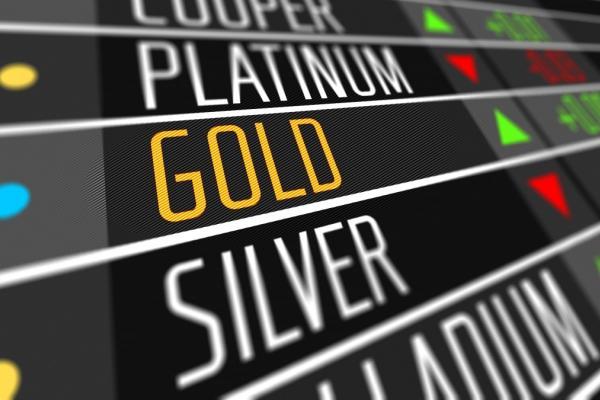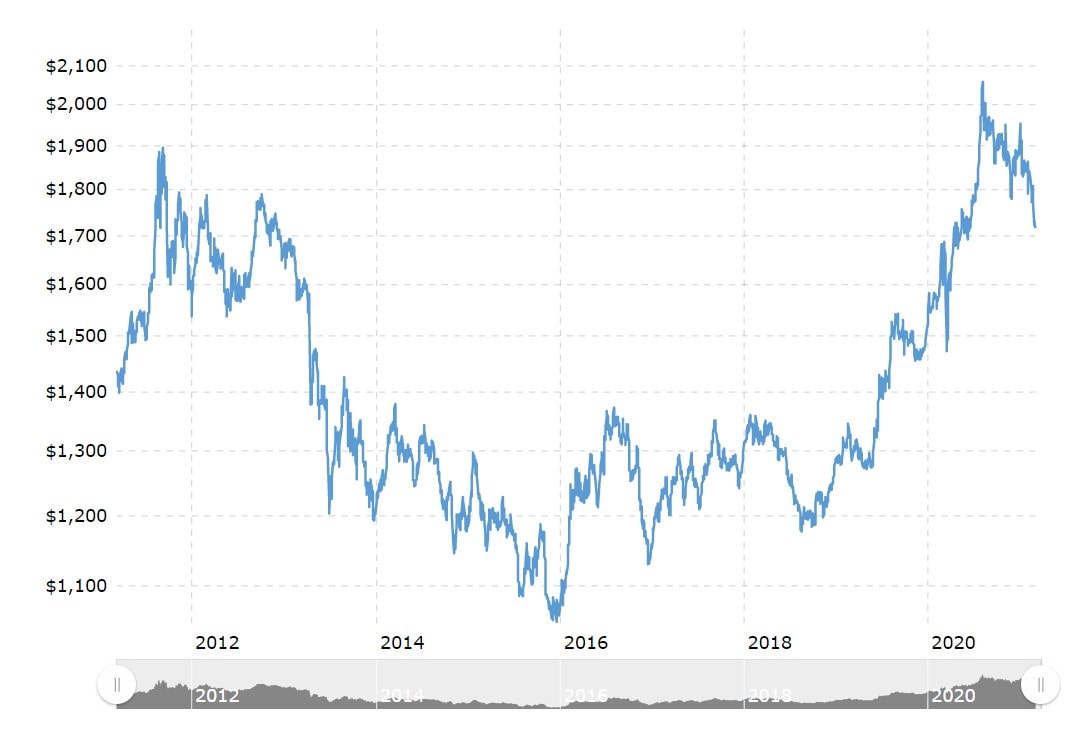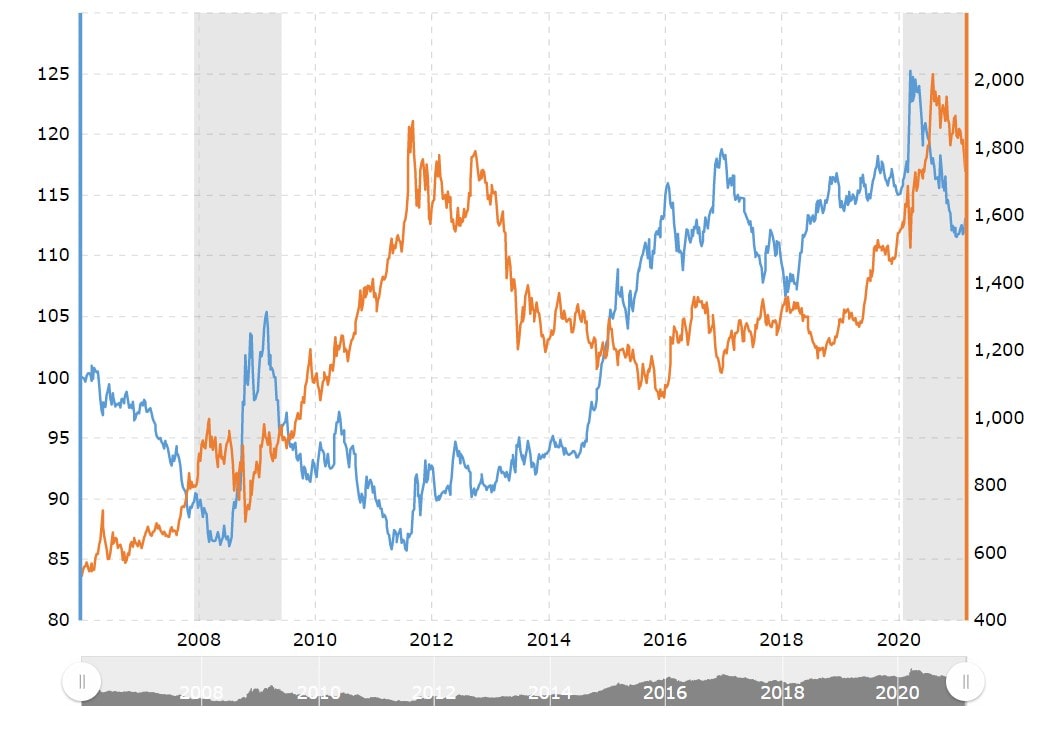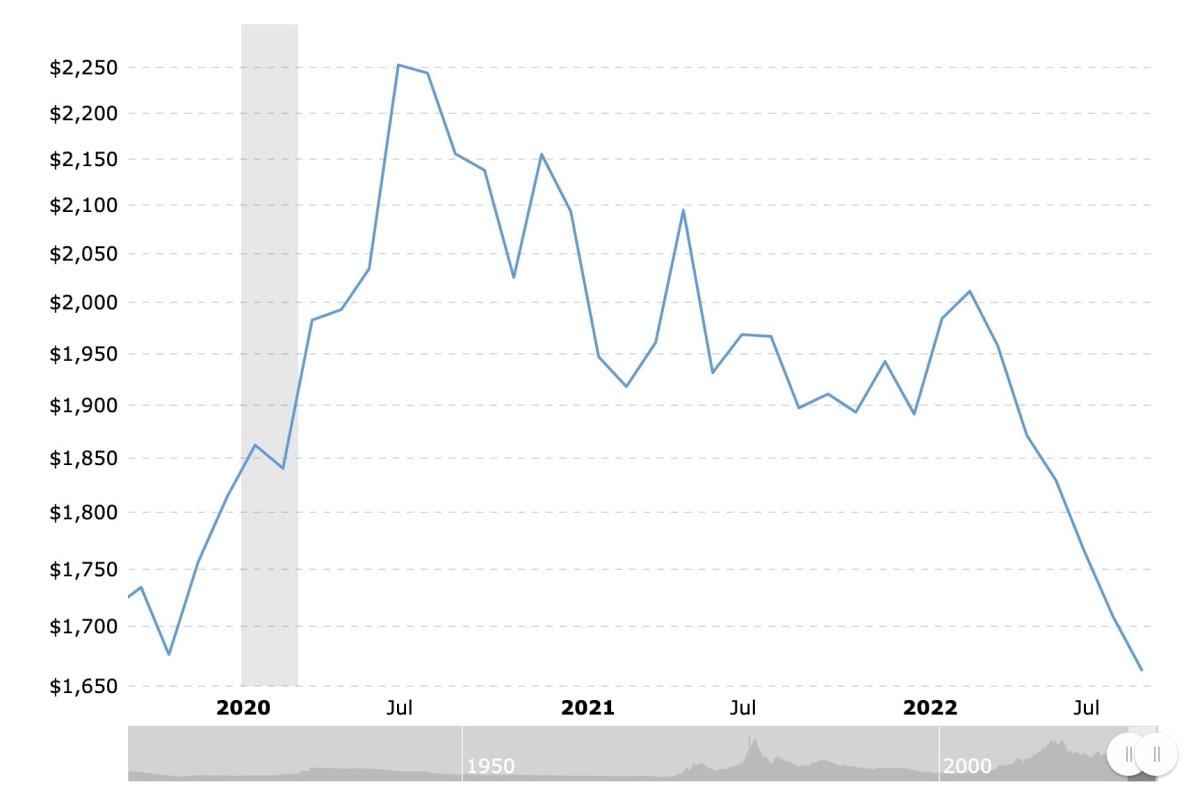

Is Gold Still Safe to Invest In? Expert Gold Price Forecasts
But, besides this, why is gold so valuable, both as a medium of exchange and as an international store of value? Why is gold #1, while silver is in second place? And while copper shares many of the same attributes as gold, it's not considered to be nearly as valuable.
In this guide on gold price forecasts, we'll take a look at why gold is considered to be so valuable, its price history and whether it will continue to increase in value in the coming years. We'll create a technical analysis, look at opinions from experts, and, ultimately, decide whether it's better to invest in gold, trade it or stay far away.
What Is Gold (XAU/USD)?
Since pretty much everybody knows what gold is, we won't spend too much time going over its definition. As a brief overview, XAU is the internationally accepted shortcode for gold; it denotes one troy ounce (oz) of gold. A troy oz is a unit of measure for weighing precious metals, and it's equivalent to 31.1 grams. This system of measurement dates back to the Middle Ages!
Now, as for gold itself, it's a shiny, yellow chemical element that has had an incredible perceived value for centuries. This precious metal is highly malleable, pretty much indestructible and is typically found in a mostly pure form.
Investing in gold comes with some inherent issues; primarily, even though it's a nonrenewable resource, it doesn't get used up. This makes it quite different from crude oil, for example. Oil is also a nonrenewable resource that takes millions upon millions of years to form. However, oil gets used up; once we run out, it's gone. This creates scarcity, which has drastic effects on the commodity's price. With gold, on the other hand, it always remains gold. You can melt down gold bars and jewellery and reuse the resulting gold. Regardless of gold's final form, its chemical composition always remains the same.
Yet, even with this supply/demand conundrum (in short, the supply will only continue to increase, even if demand halts), human societies have been fascinated by gold for ages. Kingdoms and empires were built and destroyed over this shiny metal. Until recent decades, gold was globally recognised as a satisfactory and even desired method of payment. Even the US monetary system was based on the so-called gold standard until the 1970s.
Gold is viewed as a good hedge against inflation, and when there is a financial crisis (such as the global economic meltdown caused by COVID-19), risk-averse investors flock to this precious metal.
Factors Influencing Gold's Price
There are several practical reasons that many investors choose gold as their commodity of choice. This will be useful for the upcoming gold price forecasts.
1. Value Over Time
For centuries, families have used gold as a way to preserve their wealth and pass it on to future generations. They understood that gold's value would not dwindle away to nothing.
2. The US Dollar
Even though the US dollar is one of the globe's most important reserve currencies, it can fall in value against other currencies (such as the period between 1998 and 2008). When this happens, the price of gold soars. For instance, during that same period of time, gold's price nearly tripled before going on to double again from 2008 to 2012. It ended up hitting $2,000 per oz!
3. Inflation
As the cost of living increases, gold's price tends to rise, as well. During high-inflation years, investors have seen gold prices increase while the stock market plunges. Why? While fiat money loses its purchasing power in high-inflation years, gold is priced in those currency units and rises in value right next to cost-of-living increases.
4. Deflation
This is a period of time in which business activity is sluggish, prices drop, and the economy has excessive debt (think the Great Depression and, to a lesser extent, the 2008 financial crisis). During such times, gold's purchasing power skyrockets because, during deflation, people hoard cash in the form of gold.
5. Geopolitically Uncertain Times
Did you know that gold is often referred to as the 'crisis commodity'? Not only do people hoard gold during times of economic insecurity, but they also buy up gold when world tensions are heightened. Gold's price tends to rise the most when people have little faith in government.
6. Supply Constraints
While, as we mentioned before, gold's supply won't dry up, there are still constraining factors on its production. The mining of new gold from mines has been dropping since 2000. It can take 5-10 years to open up a new gold mine, so when mines close, this can increase gold prices.
Gold Price History for the Last 10 Years
In the chart below, you can see the fluctuations of gold between 2011 and 2021. It started out the 10-year period with a spike up to $1,900 per oz, but it declined and then plummeted to under $1,100 per oz in late 2015. Come 2020, though, gold experienced a hefty increase and surpassed the $2,000 mark.

Of course, gold's price over 10 years is simply numbers. It's more important to understand the factors behind those numbers. We've compiled a timeline of events that have contributed to the ups and downs of the gold price history for 10 years.
- 2011: Because of this year's debt crisis, gold hit $1,917 in August.
- 2012: Stocks rose this year, so, conversely, gold fell.
- 2013: Gold was relatively stable this year.
- 2014: The dollar was strong, so gold didn't see any significant increases.
- 2015: As the dollar continued to strengthen, gold fell to $1,050 in December.
- 2016-2017: The dollar finally began to weaken, and gold strengthened.
- 2018: The dollar strengthened once more, and gold declined.
- 2019: The COVID-19 outbreak occurred, and gold's value soared.
As you can see, the chart is a visualisation of gold's direct tie to the value of the dollar and times of crisis. For further evidence, look at this chart, which shows gold's value compared to the dollar's value since 2006.

How Is Gold Doing Now?
Did you notice in the charts above that gold's price shot up in 2019 and 2020? That's where we can see the direct impact that COVID-19 had on this precious metal. COVID certainly created a 'golden' opportunity for investors, which we'll examine. In March 2020, the Federal Reserve decided to cut interest rates to just above zero. In addition to that, they bought hundreds of billions of dollars worth of bonds, which dragged down yields in fixed-income markets. This swayed investors to buy gold instead. As demand rose, so did the price.
Does this mean that you should get in on gold now? Not necessarily. While its price increased by around 22% during 2020, it has slipped in 2021.
Spot gold prices fell by about 6% in 2021, settling at over $1,800 per oz at the time. The decrease continued in 2022, and the current price of gold as of 15 September 2022 is $1,662.58 per oz.

There are 3 key reasons for this:
- Weakening physical demand: Bank of America analysts stated that there are signs of "fading demand" for gold by central banks. The YoY gold purchases by central banks declined by 60% in 2020. Because gold's performance during the height of the pandemic increased reserve portfolios, many central banks took advantage and obtained liquidity.
- Disappointing jewellery market: The analysts also noticed that jewellery sales have dropped. The weakness in the Indian jewellery market was even more intensified by the pandemic. Furthermore, jewellery sales even dropped in China, which is one of the globe's biggest markets for luxury goods.
- Vaccines are creating prospects for economic growth: Changes in the global economic climate have swayed many investors away from gold recently. As US lawmakers are debating a huge stimulus package and COVID vaccines are being rolled out worldwide, economic growth seems more likely. And typically, when the economy is strong, gold falls.
It may be too late to leverage the impact that COVID had on gold. However, you can still find an advantageous time to invest by keeping your finger on the world's economic pulse.
Short-Term Gold Price Predictions for 2022
Want to know how gold is anticipated to perform in the short run? This 2022 price prediction from WalletInvestor
|
Month |
Opening price ($) |
Closing price ($) |
Minimum price ($) |
Maximum price ($) |
Change |
|
October 2022 |
1,700.21 |
1,703.35 |
1,699.77 |
1,704.25 |
0.18% |
|
November 2022 |
1,702.58 |
1,695.71 |
1,695.65 |
1,702.58 |
-0.4% |
|
December 2022 |
1,695.32 |
1,696.81 |
1,687.54 |
1,696.81 |
0.09% |
Summary: In October 2022, gold is forecasted to stay above $1,700. By the end of the year, gold's price could be between $1,687.54 and $1,696.81. Source: WalletInvestor
Longer-Term Gold Price Forecasts: 2023, 2024, and 2025
WalletInvestor has published month-to-month gold price forecasts for 2023 to 2025. We find that this source offers the most realistic expectations for gold. It's neither an overly bearish nor bullish gold forecast. Here are their predictions:
|
Month |
Opening price ($) |
Closing price ($) |
Minimum price ($) |
Maximum price ($) |
Change |
|
January 2023 |
1,702.35 |
1,733.59 |
1,702.35 |
1,733.59 |
1.8% |
|
February 2023 |
1,734.77 |
1,766.10 |
1,734.77 |
1,766.36 |
1.77% |
|
March 2023 |
1,766.47 |
1,761.98 |
1,758.01 |
1,766.47 |
-0.25% |
|
April 2023 |
1,764.80 |
1,770.51 |
1,764.80 |
1,773.16 |
0.32% |
|
May 2023 |
1,769.62 |
1,778.10 |
1,766.17 |
1,778.10 |
0.48% |
|
June 2023 |
1,778.71 |
1,775.62 |
1,775.62 |
1,782.53 |
-0.17% |
|
July 2023 |
1,775.49 |
1,800.49 |
1,774.96 |
1,800.49 |
1.39% |
|
August 2023 |
1,801.71 |
1,830.66 |
1,801.71 |
1,830.66 |
1.58% |
|
September 2023 |
1,830.85 |
1,838.47 |
1,830.85 |
1,839.21 |
0.41% |
|
October 2023 |
1,838.78 |
1,841.52 |
1,838.31 |
1,842.68 |
0.15% |
|
November 2023 |
1,841.51 |
1,834.22 |
1,834.22 |
1,841.51 |
-0.4% |
|
December 2023 |
1,833.66 |
1,833.47 |
1,825.90 |
1,833.66 |
-0.01% |
Summary: Gold is anticipated to enter 2023 between $1,702.35 and $1,733.59 per oz. It could close out the year between $1,825.90 and $1,833.66 per oz. Source: WalletInvestor
|
Month |
Opening price ($) |
Closing price ($) |
Minimum price ($) |
Maximum price ($) |
Change |
|
January 2024 |
1,838.71 |
1,872.23 |
1,838.71 |
1,872.23 |
1.79% |
|
February 2024 |
1,872.99 |
1,904.91 |
1,872.99 |
1,904.92 |
1.68% |
|
March 2024 |
1,904.60 |
1,899.64 |
1,896.60 |
1,904.60 |
-0.26% |
|
April 2024 |
1,902.34 |
1,907.83 |
1,902.34 |
1,911.61 |
0.29% |
|
May 2024 |
1,907.67 |
1,916.79 |
1,904.68 |
1,916.79 |
0.48% |
|
June 2024 |
1,919.15 |
1,914.54 |
1,914.54 |
1,921.09 |
-0.24% |
|
July 2024 |
1,914.23 |
1,940.14 |
1,913.42 |
1,940.14 |
1.34% |
|
August 2024 |
1,941.70 |
1,968.81 |
1,941.70 |
1,968.81 |
1.38% |
|
September 2024 |
1,970.72 |
1,977.38 |
1,970.72 |
1,977.76 |
0.34% |
|
October 2024 |
1,976.89 |
1,980.03 |
1,976.79 |
1,981.15 |
0.16% |
|
November 2024 |
1,979.41 |
1,972.54 |
1,972.54 |
1,979.41 |
-0.35% |
|
December 2024 |
1,972.07 |
1,976.38 |
1,964.47 |
1,976.38 |
0.22% |
Summary: Gold is anticipated to enter 2024 between $1,838.71 and $1,872.23 per oz. It could close out the year between $1,964.47 and $1,976.38 per oz. Source: WalletInvestor
|
Month |
Opening price ($) |
Closing price ($) |
Minimum price ($) |
Maximum price ($) |
Change |
|
January 2025 |
1,978.41 |
2,011.03 |
1,978.41 |
2,011.03 |
1.62% |
|
February 2025 |
2,014.52 |
2,043.16 |
2,014.52 |
2,043.32 |
1.4% |
|
March 2025 |
2,043.30 |
2,039.92 |
2,035.03 |
2,043.30 |
-0.17% |
|
April 2025 |
2,040.24 |
2,046.79 |
2,040.24 |
2,050.19 |
0.32% |
|
May 2025 |
2,046.23 |
2,054.42 |
2,043.30 |
2,054.42 |
0.4% |
|
June 2025 |
2,056.97 |
2,053.05 |
2,053.05 |
2,059.54 |
-0.19% |
|
July 2025 |
2,052.37 |
2,078.17 |
2,051.94 |
2,078.17 |
1.24% |
|
August 2025 |
2,079.54 |
2,106.77 |
2,079.54 |
2,106.77 |
1.29% |
|
September 2025 |
2,108.66 |
2,115.49 |
2,108.66 |
2,116.27 |
0.32% |
|
October 2025 |
2,115.75 |
2,118.37 |
2,115.31 |
2,119.76 |
0.12% |
|
November 2025 |
2,117.75 |
2,111.35 |
2,111.35 |
2,117.75 |
-0.3% |
|
December 2025 |
2,111.06 |
2,114.81 |
2,102.96 |
2,114.81 |
0.18% |
Summary: Gold is anticipated to enter 2025 between $1,978.41 and $2,011.03 per oz. It could close out the year between $2,102.96 and $2,114.81 per oz. Source: WalletInvestor
What About Further Out in the Future? Gold Price Forecasts for 2030-2050 (and Beyond)
Because gold is so closely tied to economic factors and geopolitical tensions, it's nearly impossible to predict its precise value more than a few years out. A gold price forecast for the next 5 years is essentially as far out in advance as we can reasonably predict. However, based on gold's past performance, we can give you a general idea of how this precious metal may move.
Based on the fact that no nation has survived long with the level of debt that the US has, the dollar is likely to plummet in just a few decades. If this happens, the price of gold would shoot up, perhaps even hitting $5,000 per oz. As long as the US dollar keeps being printed at a disastrously high rate, gold will trend upwards overall and recover from downtrends fairly quickly.
Another consideration is that mercury is being phased out of the jewellery production process, as it can have terrible health effects. Replacing mercury with other amalgamation methods will impact the gold supply, making it more expensive and labour-intensive to produce. And, when that happens, gold will become more expensive. Come 2050, we may experience gold prices as high as $10,000, especially if the US economy collapses entirely. However, as you can imagine, it could be fruitless to go off of a hypothetical gold price chart for 30 years in the future.
Technical Analysis of Gold's Price
In order to keep track of gold's price movements and decide advantageous times to enter/exit the market, it's crucial to learn to create and read technical analysis. We'll show you how to create one and provide an example.
To a beginner, a technical analysis chart might seem intimidating. However, it's there to help you, not hurt you! It's a tool used by traders to predict market movements and turn a profit. While tech analysis is not foolproof, it can help you make educated guesses rather than risky gambles.
You simply can't be a successful short-term trader without using technical analysis tools. Either that or you need incredible, unending luck.
To create technical analysis charts, you'll first need to choose a platform. Libertex is a great place to do this. We offer all known indicators, and you can even create a free demo account to practice your trading skills.
Technical analysis indicators offered by Libertex can be broken into 3 categories:
- Trend: These tell you which direction the market is moving in. Types include MACD, Moving Average, Ichimoku Cloud, Directional Movement Index and many more.
- Oscillators: These are momentum indicators that show fluctuations bound by an upper and lower band. Some options include the Relative Strength Index, Stochastic Oscillator, True Strength Indicator and TRIX.
- Volatility: These show you how much a price is changing during a specific period of time. Libertex offers Donchian Channels, Bollinger Bands, the Relative Volatility Index and other volatility indicators.
Now, all you need to do is open a chart on your platform of choice, select the tradeable asset (in our case, gold), and select the trading indicators. For an explanation of what common indicators actually mean, check out this newbie-friendly guide from Investopedia.
Now, this is where your timeline comes into play. If you're an intraday trader (meaning you make several trades throughout the day), this specific moment in time would be ideal for buying. For daily and monthly traders, though, the indicators show that gold is a strong sell.


Long-Term Gold Price Forecasts by Experts
Many experts have weighed in on how gold's price may perform over the next few years to decades. We've compiled some of the most relevant gold price forecasts for your convenience.
Ed Moy
Ed Moy, the former US Mint Director, foresees gold hitting new record-highs over the next year or two. This means that it would need to break above the $2,000 mark once more. Moy stated in an interview with S&P Global Market Intelligence that the economic recovery would be very slow after the COVID-19 vaccine is administered, giving gold prices plenty of time to rise.
The London Bullion Market Association (LBMA)
The LBMA gold price forecast discussed the top 3 drivers of gold's price (falling US interest rates, a weaker US dollar and overall US fiscal policy). The Association actually compiled opinions from a variety of experts and put them in a bar chart. By clicking on each expert's name on the chart, you're sent directly to their commentary on the price of gold. We strongly recommend checking out this resource!
Morgan Stanley
Gold strategists from Morgan Stanley actually lowered their predictions for gold's price in 2022. They predict that gold will have an average of $1,745 in 2022.
Nicoya Research
This research group, which provides educational materials for independent investors, foresees gold reaching $4,500 in 2022 and will even break the $6,000 mark in 2025. Why? They said that the previous gold bull cycle increased the price of gold by 600%. Therefore, since gold is in a bull cycle now, we could anticipate similar figures.
What to Do With Gold: Trade or Invest?
There is no guarantee of profit with gold investments. While it's typically seen as a safe investment, its performance has a converse relationship with economic prosperity. This precious metal has its ups and downs, and there's no guarantee that it will always increase in price. Therefore, before investing in gold, it's crucial to read opinions from experts, examine market trends and create technical analysis charts.
If you want to get in on gold but aren't ready to make a long-term investment, perhaps trading CFDs would be a better choice. When you trade CFDs, you can make a profit from the volatility of gold by speculating on its future price. The Libertex trading platform enables savvy traders to trade CFDs for gold and more.
FAQ
Is Gold a Good Investment in 2022?
It’s not clear whether gold is a good investment. The price is currently experiencing some slippage. But it often happens that geopolitical tensions and further economic instability contribute to the price of gold shooting up.
Is Gold Worth Buying?
The answer to whether gold is worth buying is still debated. Traditionally, it’s considered one of the safest precious metals to invest in, but financial markets give no guarantees.
What Will Gold Be Worth in 2025?
This is a bit too far in the future to provide an exact estimate. However, we could reasonably expect gold to enter 2025 above the $2,000 mark.
Is Gold's Price Expected to Drop?
Gold's price will likely drop when vaccines are fully rolled out and national economies stabilise.
What Will Gold Be Worth in 2030?
This depends on the state of the world. In an ideal scenario, we could see gold at $5,000+ in 2030.
Is It Wise to Invest in Gold Now?
It's wise to study the market and keep your finger on the economic pulse of the world. We recommend studying this precious metal carefully before making a decision. Remember: if you aren't comfortable with making a long-term investment, you can always trade CFDs!
Will Gold's Price Rise in the Future?
Most analysts expect the price of gold to rise in the future.
Disclaimer: The information in this article is not intended to be and does not constitute investment advice or any other form of advice or recommendation of any sort offered or endorsed by Libertex. Past performance does not guarantee future results.
Why trade with Libertex?
- Get access to a free demo account free of charge.
- Enjoy technical support from an operator 5 days a week, from 9 a.m. to 9 p.m. (Central European Standard Time).
- Use a multiplier of up to 1:30 (for retail clients).
- Operate on a platform for any device: Libertex and MetaTrader.